GAS EXCHANGE AND SURFACE AREA
1/60
There's no tags or description
Looks like no tags are added yet.
Name | Mastery | Learn | Test | Matching | Spaced |
|---|
No study sessions yet.
61 Terms
WHY DOES VOLUME AFFECT THE RATE OF GAS PRODUCTION/USE?
Bigger volume = bigger cells and :: increased use of oxygen and production of carbon dioxide in respiration.
WHY IS OXYGEN UPTAKE A MEASURE OF METABOLIC RATE IN ORGANISMS?
Oxygen used in respiration, which provides energy / ATP
WHY CAN SMALL ORGANISMS MEET ALL OF THEIR GAS EXCHANGE REQUIREMNETS THOUGH THEIR CSM ONLY?
They have large SA:V ratios.
WHY DO SMALLER ORGANISMS NEED TO RESPIRE FASTER?
They have large SA:V ratios so they lose heat faster.
They need a higher metabolic rate to respire faster to replace lost heat.
HOW DOES EFFICIENT GAS EXCHANGE OCCUR IN SMALL ORGANISMS?
[gradients] = continuous aerobic respiration.
Diffu pathway = Large SA:V.
SA = Small size (may have folds).
USING YOUR KNOWLEDGE OF SA:V RATIO, EXPLAIN THE HIGHER METABOLIC RATE OF A SMALL ORGANISM COMPARED TO A LARGE ONE?
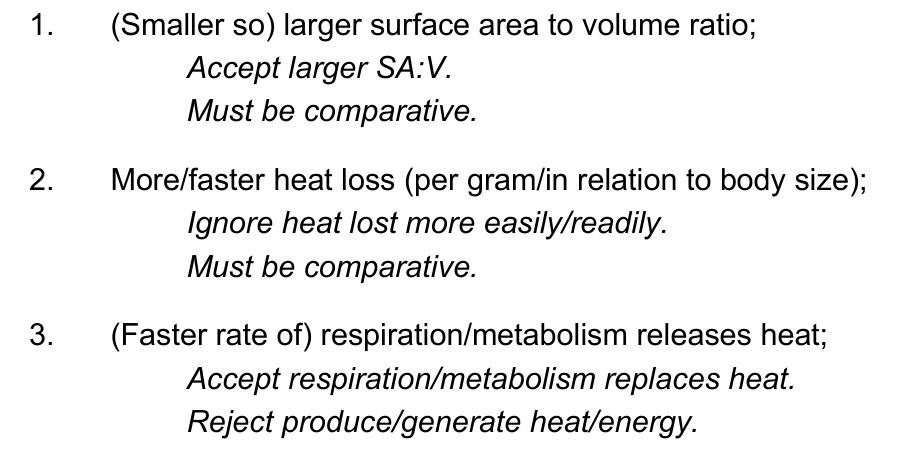
EXPLAIN THE ADVANTAGE FOR LARGER ANIMALS OF HAVONG A SPECIALISED SYSTEM THAT FACILITATES OXYGEN UPTAKE?
Large(r) organisms have a small(er) surface area:volume (ratio).
OR Small(er) organisms have a large(r) surface area:volume (ratio);
Overcomes long diffusion pathway
OR Faster diffusion;
Accept short diffusion pathway Accept for ‘faster’, more
WHERE ARE THE GILLS?
WHAT ARE THEY THE FISH EQUIVALENT OF?
WHAT ARE THEY (colour)?
Gills are between the buccal cavity and operculum.
They are like ribs.
They are bright red due to blood flow.
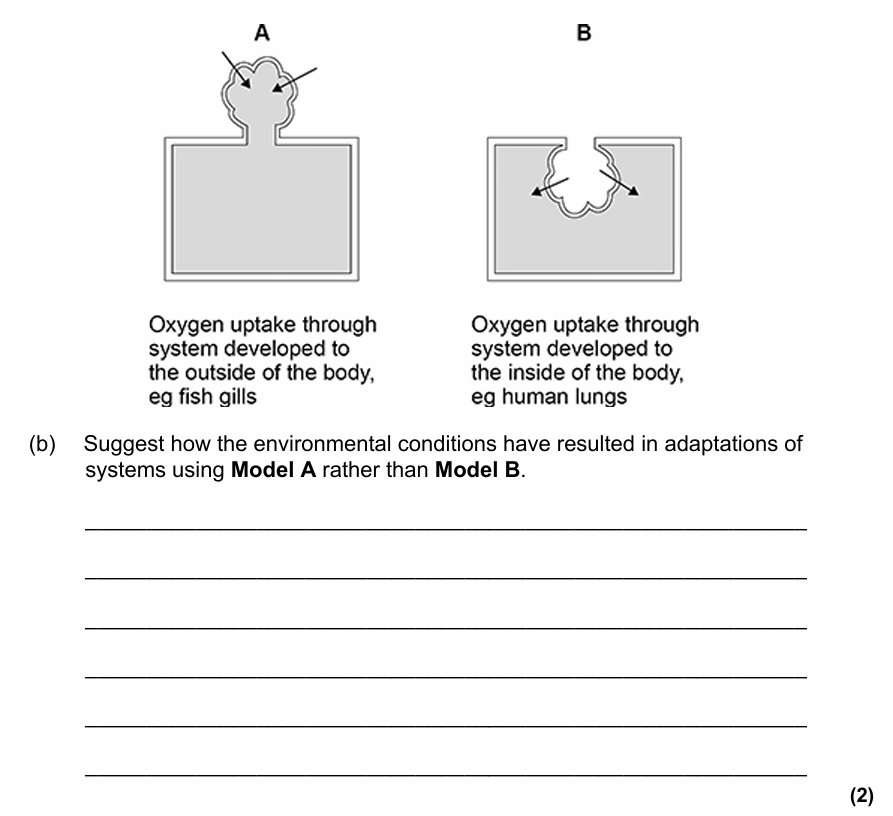

WHAT DO THE LAMELLAE DO?
SA.
WHAT IS THE GAS EXCHANGE SURFACE IN FISH?
Lamellae (90* angles).
FICKS LAW OF FISH?
SA:
Each gill has many thin walled filaments.
Which have many lamellae.
Many blood capillaries.
PATH:
Capillary endothelium, lamellae, and epithelium are all thin.
CONC:
Counter current.
Continuous blood flow to capillaries ensures saturated oxygen is quickly removed.
WHAT IS THE COUNTER CURRENT SYSTEM?
Water flows in one direction and blood in the opposite, maintaining a steep [gradient].
Oxygen in water is always higher than blood.
(Oxygen gradient persists) Across the entire gill length/filemant.
WHY IS THE COUNTER CURRENT SYSTEM BETTER THAN THE PARALLEL FLOW SYSTEM?
Prevents equilibrium from being reached.
HOW DO FISH MAINTAIN A CONSTANT FLOW OF WATER OVER THEIR GILLS?
Mouth opens, operculum closes.
Floor of mouth lowered.
Volume :: pressure, water enters.
Mouth closes, operculum opens.
Floor of mouth raised.
Volume :: pressure, water pushed over gills.
WHY IS THE CONSTANT FLOW OF WATER NEEDED FOR EFFICIENT GAS EXCHANGE?
To allow the counter current process to occur.
HOW IS WATER LOSS MINIMISED ACROSS THE BODY SURFACE OF INSECTS?
The outermost layer is waxy and waterproof.
Chitin (rigid) is waterproof.
Hair on spiracles increase moisture.
Valves can close spiracles.
Small SA:V to area over which water can be lost.
WHY DO INSECTS NEED A SPECIALISED EXCHANGE SYSTEM?
Their tough exoskeleton prevents them from using their body surface for diffusion.
WHAT IS THE TRACHEAL SYSTEM?
A network of tracheae (air filled tubes) that open to the outside through spiracles (small holes in the exoskeleton).
WHY ARE THE SPIRACLES SPIRALLY?
They have rings of chitin.
These add support to prevent the collapse of the respiratory system.
:: prevents death.
DIAGRAM OF THE RESTING INSECT’S TRACHEAL SYSTEM?
Body wall is cuticle.
Cells have fluid.
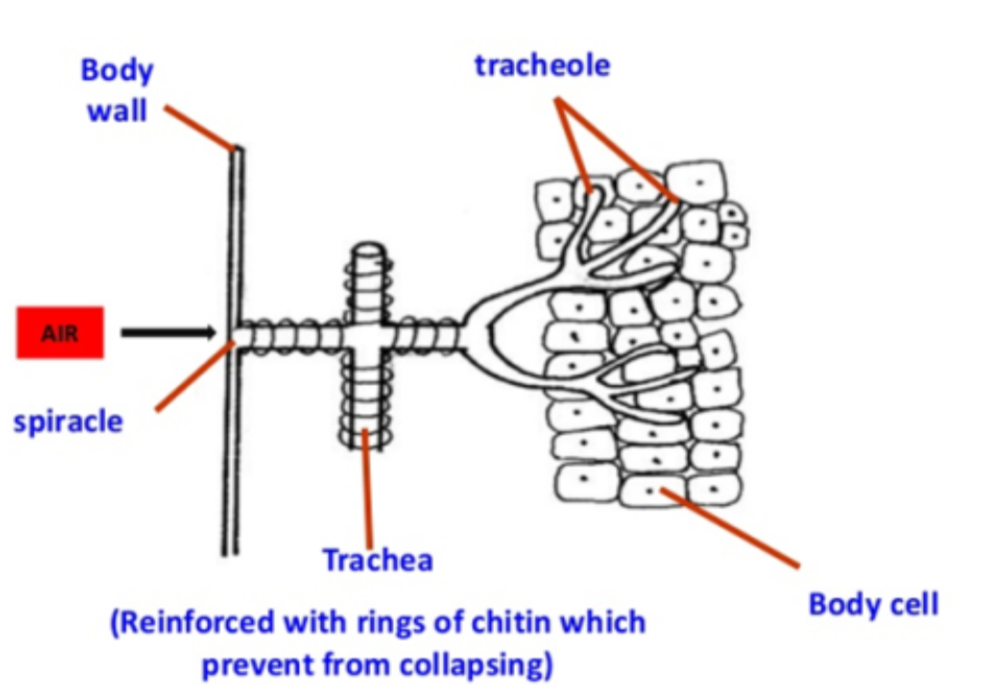
WHY IS THERE FLUID AS A PART OF THE TRACHEAL SYSTEM?
Diffusion occurs faster in gases.
As (soluble) lactic acid, Ψ.
H20 will move osmosis in.
Now O can diffuse in faster.
SA in contact with O.
WHAT IS THE SITE OF GAS EXCHANGE?
Tracheoles.
O diffuses directly into cells from them.
IS THERE VENTILLATION IN INACTIVE/SMALL INSECTS?
WHY?
No.
They rely on [gradient] created by respiration.
FICK’S LAW IN RESTING INSECTS?
SA:
Large no. trachea.
PATH:
Thin walled tracheoles.
Tracheoles in close proximity to cells.
CONC:
Cells respire.
EXPLAIN SIX WAYS IN WHICH AN INSECTS TRACHEAL SYSTEM IS ADAPTED FOR EFFICENT GAS EXCHANGE?
Tracheoles have thin walls so short diffusion distance to cells;
Highly branched / large number of tracheoles so short diffusion distance to cells;
Highly branched / large number of tracheoles so large surface area (for gas exchange);
Tracheae provide tubes full of air so fast diffusion (into insect tissues);
Fluid in the end of the tracheoles that moves out (into tissues) during exercise so faster diffusion through the air to the gas exchange surface; OR Fluid in the end of the tracheoles that moves out (into tissues) during exercise so larger surface area (for gas exchange);
Body can be moved (by muscles) to move air so maintains diffusion / concentration gradient for oxygen / carbon dioxide;
FICK’S LAW IN ACTIVE INSECTS?
SA + PATH = Same.
CONC:
Abdominal pumping.
Remove fluid from the ends of tracheoles.
WHAT IS ABDOMINAL PUMPING?
Ventilation by contraction of the abdomen muscles.
Can force air in and out of the spiracles and trachea.
To maintain a greater airflow and maintain steeper [gradients].
FICK’S LAW IN PLANTS?
SA:
Spongy mesophyll layer cells are loosely packed, creating numerous air spaces.
PATH:
Spongy cells have thin cell walls.
Spongy cells directly in contact with air.
Many stomata.
Leaf is thin.
CONC:
Respiration.
Photosynthesis.
WHERE DO GASES ENTER AND LEAVE PLANTS?
Spongy mesophyll layer is in close contact with stomata (pores) where the gases leave and enter.
GAS EXHANGE SURFACE IN PLANTS?
Spongy mesophyll layer.
HOW DO PLANTS MINIMISE WATER LOSS?
Guard cells swell up to close stomata.
Waxy cuticle.
USE YOUR KNOWLEDGE OF GAS EXCHANGE IN LEAVES TO EXPLAIN WHY PLANTS GROWN IN SOIL WITH VERY LITTLE WATER GROW ONLY SLOWLY?
Stomata close;
Less carbon dioxide (uptake) for less photosynthesis/glucose production;
LEAF DIAGRAM?
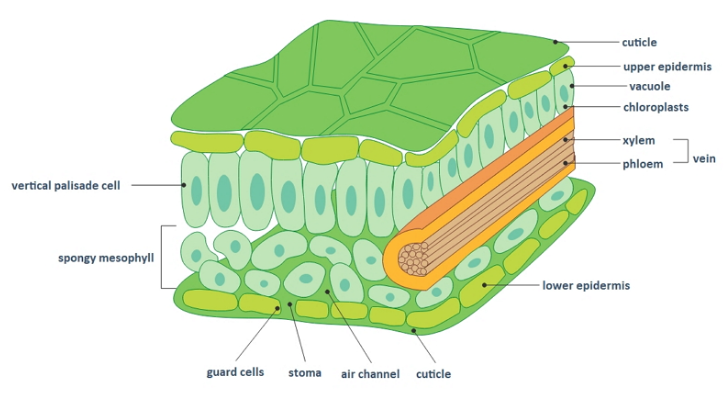
LUNG DIAGRAM?
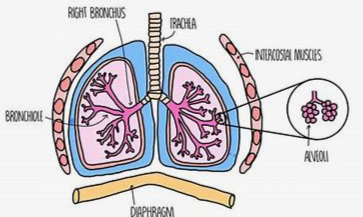
FUNCTION OF THE LUNGS?
To allow gaseous exchange between the air in the lungs and blood in the capillaries.
WHY IS GAS EXHANGE NEEDED?
Maintain constant supply of O to release E in the form of ATP for bodily function.
Remove CO2 otherwise it would lower pH dangerously (and denature enzymes).
WHY MUST LARGE VOLUMES OF GASES BE EXHANGED IN MAMMALS?
Warm blooded.
Small SA:V.
Large rate of respiration.
WHAT LINES THE AIRWAY + PURPOSE?
Mucus membranes.
Trap microorganisms and debris.
Keep airways clear.
WHAT DO MUCUS MEMBRANES CONTAIN +PURPOSE?
Goblet cells.
Secrete mucus.
Lined with ciliated epithelium.
ROLE OF CILLIA?
Beat regularly to move microorganisms and dust particles along with mucus.
PATHWAY OF AIR?
Air enters the airway through mouth/nose.
Air passes into trachea, then bronchi, then bronchioles.
Then alveoli.
DIAGRAME OF ALVEOLI?
FICK’S LAW OF ALVEOLI?
(Capillary wall also capillary endothelium.)
Moist - allows it to absorb gases.
Elastic tissue - maintains concentration (like a balloon).
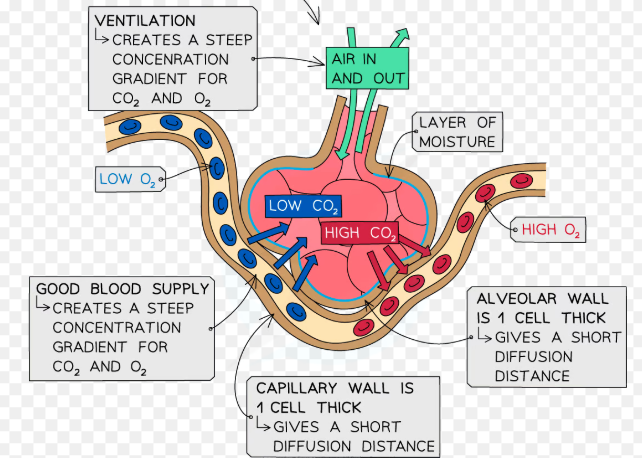
PATHWAY FROM ALVEOLI TO BLOOD?
Oxygen diffuses through the alveoli's epithelium.
Blood capillaries' endo/epithelium.
Here, it combines with haemoglobin in the RBC.
This maintains the [gradient].
Capillaries = one cell thick.
EXPLAIN WHY DEATH OF ALVEOLAR EPITHELIUM CELLS REDUCES GAS EXCHANGE IN LUNGS?
Reduced surface area;
Increased distance for diffusion
Reduced rate of gas exchange;
GAS EXHANGE AREA IN LUNGS?
Alveoli.
FICK’S LAW IN LUNGS?
SA:
Millions of alveoli.
Large SA of blood capillaries.
Lungs are compact.
THIN:
Only two layers of cells between air in alveoli and blood in capillaries:
Squamous epithelial of alveoli wall (thin epithelial cells).
Squamous epithelial of capillary wall.
Lungs are thin-walled.
CONC:
Capillaries provide good blood flow.
Highly elastic, maintains shape of alveoli and lungs, can expand and recoil during breathing.
Respiration.
Ventillation.
WHAT IS INSPIRATION?
IS IT PASSIVE?
Taking air into the thorax.
Passive.
QUANITITIES OF GASES EXHALED?
O = 16%
CO2 = 4%
N = 78%
WHY DOES AIR ENTER?
Air is drawn into the lungs when pressurethorax < pressureat.
Since the thorax is airtight, and the only opening to the outside is through the trachea.
DESCRIBE THE RELATIONSHIP BETWEEN VOLUME AND PRESSURE?
Inversely proportional.
WHAT DOES THE EXTERNAL INTERCOSTAL DO DURING INSPIRATION?
WHAT DOES THIS CAUSE THE DIAPRAGM TO DO?
Contracts.
D contracts and moves down.
VOLUME CHANGE DURING INSPIRATION?
Increases.
HOW DO THE INTERCOSTSTAL MUSCLES BRING ABOUT INSPIRATION?
They CONTRACT.
Diaphragm contacts and goes down + ribs pulled up and out.
:: Volumethorax :: Pressurelungs.
Pressureat > Pressurepulm :: air forced into lungs.
DESCRIBE THE GROSS STRUCTURE OF THE HUMAN GAS EXCHANGE SYSTEM AND HOW WE BREATHE IN AND OUT?
Named structures – trachea, bronchi, bronchioles, alveoli;
Reject mp1 if structures from other physiological systems are named but award mp2 if the correct structures are in the correct order.
Above structures named in correct order .
Breathing in – diaphragm contracts and external intercostal muscles contract;
Volume increase and pressure decrease in thoracic cavity (to below atmospheric, resulting in air moving in).
Breathing out - Diaphragm relaxes and internal intercostal muscles contract;
Volume decrease and pressure increase in thoracic cavity (to above atmospheric, resulting in air moving out);
CHANGES IN EXPIRATION WHEN ITS ACTIVE?
Its active.
External relax :: internal contract (agonist).
:: ribcage pulled further down and in.
WHAT IS TIDAL VOLUME?
Volume of air breathed in/out of the lungs in a normal resting breath.
SUGGEST AND EXPLAIN WHY A REDUCED TIDAL VOLUME EFFECTS THE EXCHANGE OF CO2 BETWEEN BLOOD AND THE ALVEOLI?
Less CO2 exhaled.
::: Reduced [gradient].
Less movement of CO2 out of blood.
VENTILLATION RATE?
Number of breaths in/out per minute.
PULMONARY VENTILLATION + FORMULA?
Total volume of air that is moved into the lungs in one minute.
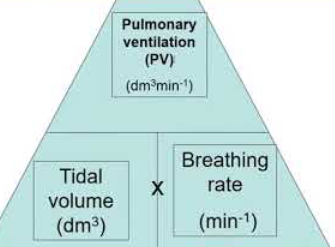
CAUSALLY LINKED?
One variable causes the other to occur.